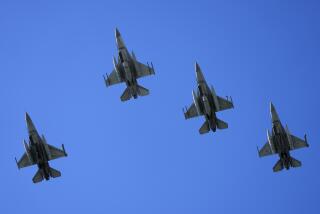Vulnerable in the Wild Blue Yonder? : Mission Changes Erode Air Force’s Claim on Independence
- Share via
In 1947, the case for an independent air service seemed compelling. The Army Air Forces, the precursor to the U.S. Air Force, possessed a monopoly of nuclear weapons. It also had a monopoly of long-range bombers, the only means then of intercontinental delivery.
Much has changed in the last 42 years. The nuclear monopoly has vanished. The Army, Navy and Marine Corps all have tactical nuclear weapons, and the Navy’s fleet of ballistic missile-firing submarines constitutes the most invulnerable “leg” of the so-called U.S. strategic nuclear triad (the others being land-based intercontinental ballistic missiles and long-range bombers).
Although the Air Force retains its monopoly of strategic bombers, their importance has suffered in relation to ballistic and cruise missiles. The manned long-range penetrating bomber may still have a healthy future in non-nuclear conflicts, but missiles are a far cheaper and more efficient way of delivering nuclear munitions inside Soviet air space. It is no coincidence that the Air Force has permitted the size of its strategic bomber force to atrophy to its smallest level since World War II.
Finally, and perhaps most important, the great argument upon which the Air Force staked its claim for independence--namely, that air power, notably strategic bombardment, would be the decisive force in future wars--has been conclusively disproved. To be sure, strategic bombardment was an indispensable element in Nazi Germany’s defeat. But Germany’s surrender was obtained first and foremost by the defeat of Hitler’s armies on the ground, rather than the destruction of cities from the air. The claim that Japan was bombed into capitulation conveniently ignores the fact that the aerial bombardment campaign--conducted against Japan from bases in the Marianas--was made possible only by almost two years of bloody naval engagements and amphibious assaults across the central Pacific that finally brought B-29s to within range of the Japanese home islands.
As for the Korean and Vietnam wars, the most that can be said for their respective air campaigns is that they prevented an outright defeat of U.S. ground forces. The view, still widely held within the Air Force, that air power could have yielded definitive military victory in both wars if not for restrictions imposed by ignorant or cowardly civilian authorities, is not supported by any hard evidence. This view also suggests that many in the Air Force have yet to accept the moral validity and strategic necessity of limited war, which by definition involves political restraints on the use of military power. (The official Air Force history of the Korean War still claims that U.S. air power could have obtained a complete victory if only it had been allowed to use nuclear weapons. The claim may be true, but it is also irrelevant).
To assert that the original circumstances and arguments for an independent Air Force no longer apply is not necessarily to conclude that the Air Force should be disestablished. On the other hand, the rationale for an independent Air Force is not nearly as self-evident as it used to be. Future developments may weaken it further.
For example, the present distribution of the strategic triad’s components between the Air Force and Navy was the product not of reason but of fierce interservice rivalry in the 1950s for the strategic nuclear mission. A case can be made, on the grounds of both peacetime administrative and wartime operational efficiency, for concentrating all three components of the triad, including the bombers and ICBMs of the Air Force’s Strategic Air Command, into a single new service. The Soviet Union, the only other comparable nuclear power, made this sensible decision almost 30 years ago when it created the Strategic Rocket Forces.
To deprive the Air Force of its strategic bombardment mission would, of course, further weaken justification for its continued independent status. The Air Force would become almost exclusively tactical, competing for resources with Navy and Marine Corps tactical aviation. Naval and Marine air power, however, are closely calibrated to the distinct and independent missions of projecting force against other navies and from sea to shore. In contrast, the tactical combat missions the Air Force--air superiority, deep interdiction and close air support--are all derivative: their ultimate purpose is to assist U.S. surface forces in achieving combat aims in a theater of operation.
Indeed, the evolution of modern combat has increasingly blurred the distinction between the aerial and ground components of land warfare. Armies, with their ever increasing numbers of helicopters, and tactical air forces are becoming increasingly dependent upon one another for their survival--a trend certain to continue. There is already sentiment on Capitol Hill for transferring at least the mission of providing close air support back to the Army.
The Air Force’s institutional vulnerability is heightened by decades of relative inattention to the two air missions of greatest importance to the Army--airlift and close air support. Neither strategic nor tactical airlift has ever commanded the kind of attention that the Air Force has paid to the far-more glamorous missions of strategic bombardment, air superiority and deep interdiction. The result, during World War II and since, has been a chronic shortage in airlift, a shortage that in some cases contributed to failed U.S. Army operations.
By all accounts, the Air Force record on close air support has been even worse, certainly when compared to the quality of close air support found in the Navy and especially the Marine Corps. The air wings and ground divisions of Fleet Marine Forces train together, with the former closely tied to ground operations. (Marine aviators must spend at least one year serving in infantry units before they ever enter the cockpit). Marine ground commanders, unlike Army commanders, do not have to go hat in hand to another, otherwise preoccupied service either for transport (courtesy of specialized ships willingly provided by the Navy) or for close air support.
Another factor bearing heavily on the Air Force’s future is the uncertain availability of land-based U.S. tactical air power for combat operations in an era of eroding U.S. basing rights overseas. The Air Force played no role during the U.S. intervention in the Persian Gulf in 1987-1988 for the simple reason that no country in the region was politically prepared to accept U.S. combat aircraft on its territory.
The general problem was succinctly summed up in the 1988 report of President Reagan’s Commission on Integrated Long-Term Strategy. “Present strategy,” the report concluded, “recognizes the potential of our air power but requires us to depend on an uncertain prospect: that if an attack seemed imminent, we could then get the needed bases. But hints of an attack, and the intimidating crisis atmosphere presumably accompanying them, could make our allies more than ever reluctant to call us in. Our major problem, then, is that, except for carrier-based aircraft and long-range land-based aircraft, we have no assured timely access for our air power.”
None of this is necessarily to argue for the Air Force’s abolition. But it is unfortunate, if understandable, that the Air Force’s preoccupation with its share of the present defense budgetary crisis has served to divert its attention from far more serious challenges in the longer term to its survival as an independent service.
More to Read
Sign up for Essential California
The most important California stories and recommendations in your inbox every morning.
You may occasionally receive promotional content from the Los Angeles Times.










